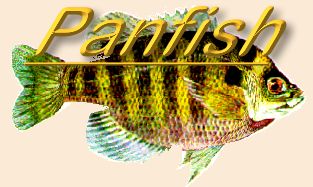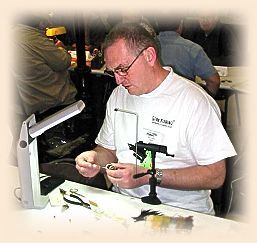|
We had several things to do on Saturday. I did not get
out to a pond until Sunday afternoon.
This was on November 12. It was about 15 degrees cooler
than Saturday had been and the wind was blowing about 20
mph. But it was the time that I could be out and I was
taking advantage of that. The water is cooling down and
the first stretch of cold weather we get will probably
end my fishing until next spring. I have been told that
the water is down to 45 degrees.
I can believe this as I retrieve a wet fly line. I was
smart enough to carry an old towel with me to wipe my
hands on. Usually this is done on my jeans, but in the
cold, windy weather that is not the best thing to do.
The jeans get wet and I get colder, faster.
It is also very nice to wipe my hands off after I raise
or lower the anchor ropes. They get wet and that makes
a difference. Dry hands stay warmer in the wind than
do wet hands.
I got to the pond that I wanted to try. This pond has crappie,
bass and green sunfish in it. I wanted to see what I might do
about getting some crappie. I noticed that the lily pads were
almost all gone. The stalks were still sticking up, but the
leaves were gone. I did not think that the crappie would be
in that shallow of water at this time of year. I would be
fishing deeper as the fish would probably be suspending in
the deeper water.
With the wind blowing as hard as it was, I had brought
two 6 wt rods with floating lines with me. I also had a
6 wt with a full sinking line on it with me. I knew the
sinking line would get deeper. This rod is not the most
fun to cast with, but it makes me pay more attention to
what I am doing while I am using it.
I went to the east end of the pond and anchored about 40
feet from the dam. I know the first ten feet of water off
the dam is only about two feet deep. To shallow to fish
at this time of year.
I wanted to be able to cast up to that and let the fly drop
as it came back out to me. I also wanted to cast along the
drop-off and retrieve the fly along at different depths.
I started with the floating lines and cast them. They did
not work on the casts to the shore. The wind was so strong
that the line bowed and I could not keep contact with the
fly. If a fish hit it I did not feel it and could not see
the fly line move. The wind was moving it to fast for me
to be able to seed the subtle changes a fish causes when
making a light strike.
Casting into the wind was no better as the wind was pushing
the line back so fast. I don't think the fly got deep enough
to reach the fish. Or if they did I was just not seeing
what was going on.
Time to go to the sinking line. Hopefully this would remove
the wind as a factor. With the line under water it would not
bow like the lines did on the surface. Also, the flies would
get deeper.
I did not have much success in casting toward the shore. I
caught a lot of salad, but no fish. I decided to cast
parallel to the dam and retrieve the fly back at different
depths and speeds. I started my retrieve on the first cast
when the fly was about two feet under the surface. I would
go deeper on each of the successive casts. I almost had the
fly back to the canoe when I saw a crappie roll on the fly.
I did hook the fish, but it was gone in about ten seconds.
I had been hooked in the side of the mouth in that thin
tissue.
If the fish came up to hit the fly I could fish deeper and
that might help. I let the next cast go deeper and felt some
weight when I started to retrieve. It was a nice crappie,
about a foot long and fat.
I cast out to the same general area and let the fly drop again.
I had retrieved about two feet of line when I felt the weight
and set the hook. Another ten second battle.
I figured out that if the fish hit on the drop, then I would
catch them. If they hit on the retrieve then I lost them.
So I cast out and if a fish did not hit the fly on the drop
then I brought the line in fast.
I had a dozen fish in the canoe when the hunters showed up
in the field south of the pond. It was time to get off the
pond and head home.
Hope you can get out on the water. ~
Rick
|



